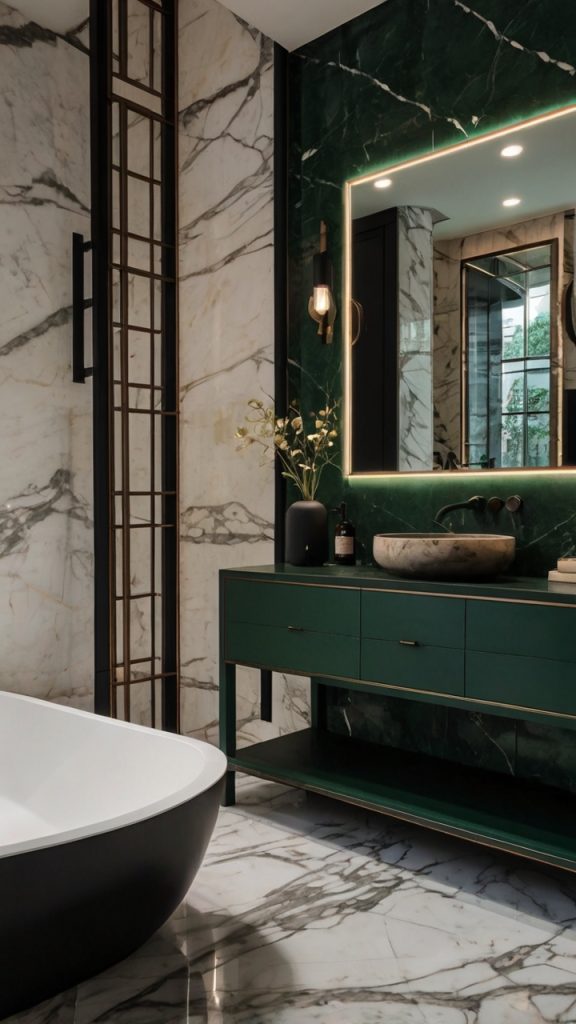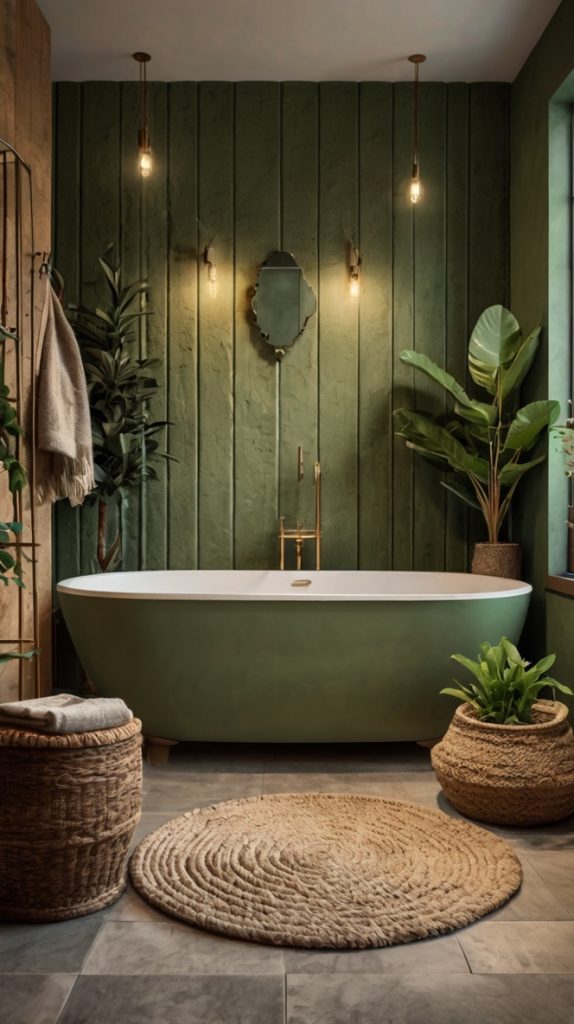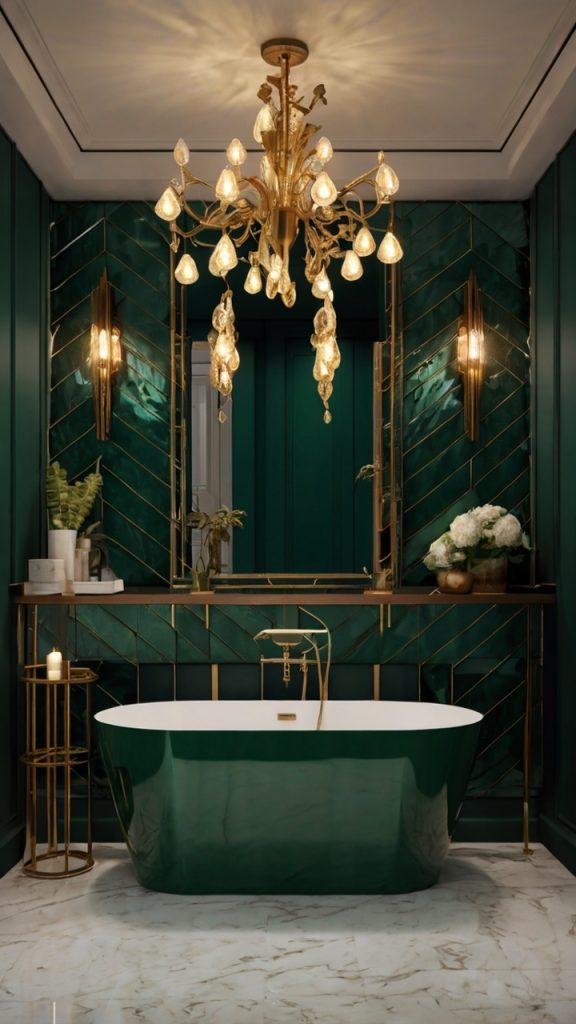15 Stunning Japandi Dining Room Ideas for Cozy Modern Spaces
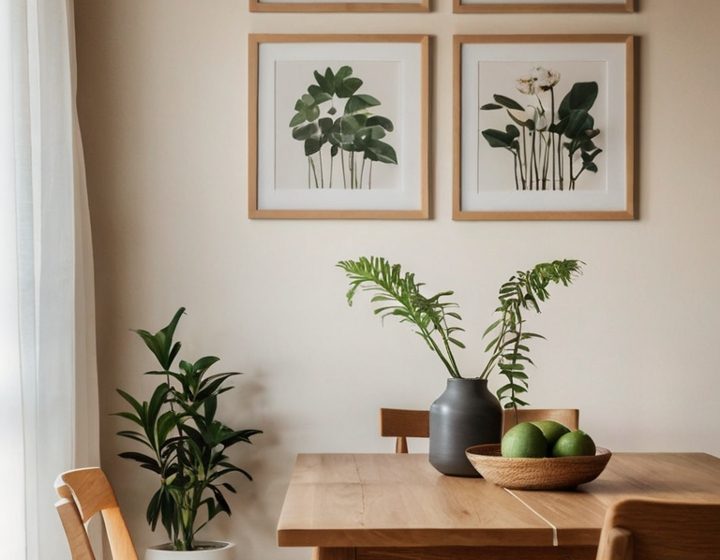
You know that feeling when you walk into a room and instantly feel… calm? That’s exactly what happened to me the first time I experienced a proper Japandi dining room. My friend Sarah had just renovated her space, and honestly, I spent the entire dinner party mentally redesigning my own dining area. The perfect blend of Scandinavian functionality and Japanese minimalism creates something magical – and I’m about to share exactly how you can nail this look.
Let me break down 15 killer Japandi dining room ideas that actually work in real life. No Pinterest-perfect-but-impossible-to-achieve nonsense here – just practical, gorgeous design choices that’ll transform your eating space into something special.
Minimalist Wooden Dining Table Setup
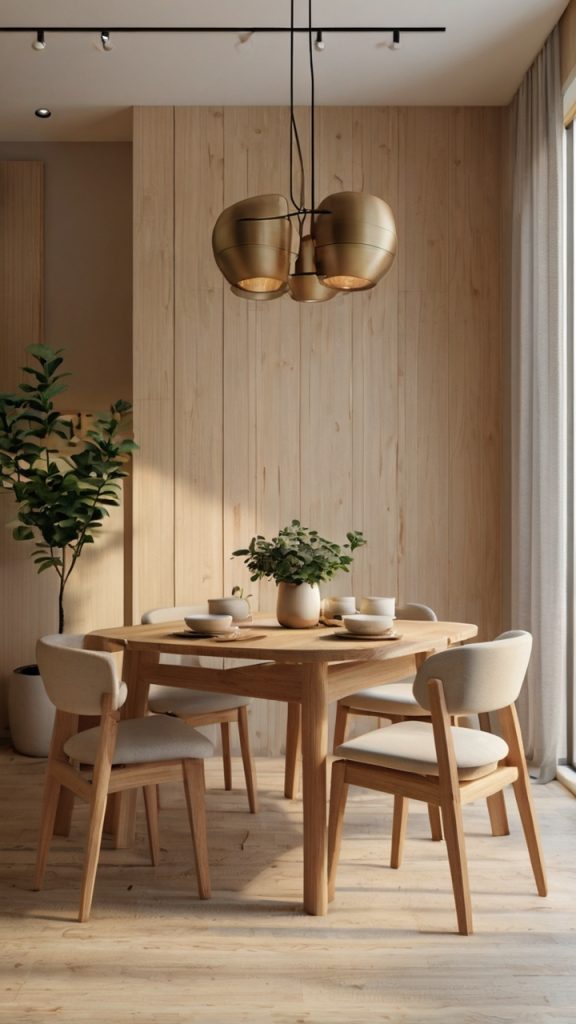
Here’s where everything starts – your dining table. I’ve learned the hard way that choosing the wrong table ruins the entire Japandi vibe faster than you can say “hygge meets wabi-sabi.”
The secret? Go for light woods like oak, ash, or pine with minimal finishing. You want to see those natural grain patterns doing their thing. My current table has this gorgeous matte finish that practically begs you to run your hands across it. Skip the glossy, overly polished pieces – they scream “furniture showroom” instead of “thoughtfully curated space.”
The shape matters too. Rectangular tables with clean lines work brilliantly, but don’t sleep on round tables either. They create this beautiful flow in the room that rectangular pieces sometimes miss. And here’s a pro tip: choose a table with slightly tapered legs – it adds visual lightness without sacrificing stability.
Size and Proportion Considerations
Keep your table proportional to your room. Sounds obvious, right? But you’d be surprised how many people stuff massive tables into tiny spaces. The Japandi aesthetic thrives on negative space – that breathing room around furniture that makes everything feel intentional rather than cramped.
Neutral Toned Japandi Wall Accents
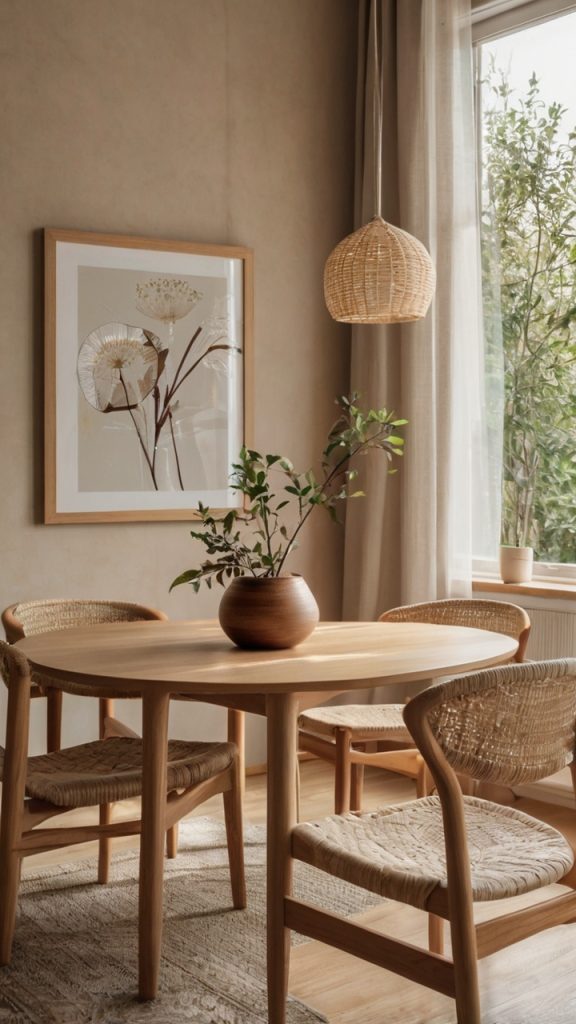
Wall colors set the entire mood, and getting this wrong basically torpedoes your whole design scheme. Trust me, I painted my dining room this “perfect” gray three times before finding the right shade.
Warm whites, soft beiges, and muted grays form your foundation palette. But here’s where it gets interesting – consider adding one accent wall in a deeper tone like charcoal or warm taupe. It creates depth without overwhelming the space. Just don’t go crazy with patterns or bold colors. Remember, we’re aiming for zen, not zealous.
Texture Over Color
Instead of relying on color for visual interest, play with textures. Consider:
- Natural plaster finishes that add subtle dimension
- Wood paneling in vertical lines for height
- Subtle grasscloth wallpaper on one wall only
- Lime wash paint for that perfectly imperfect look
Scandinavian Chairs with Japanese Touch
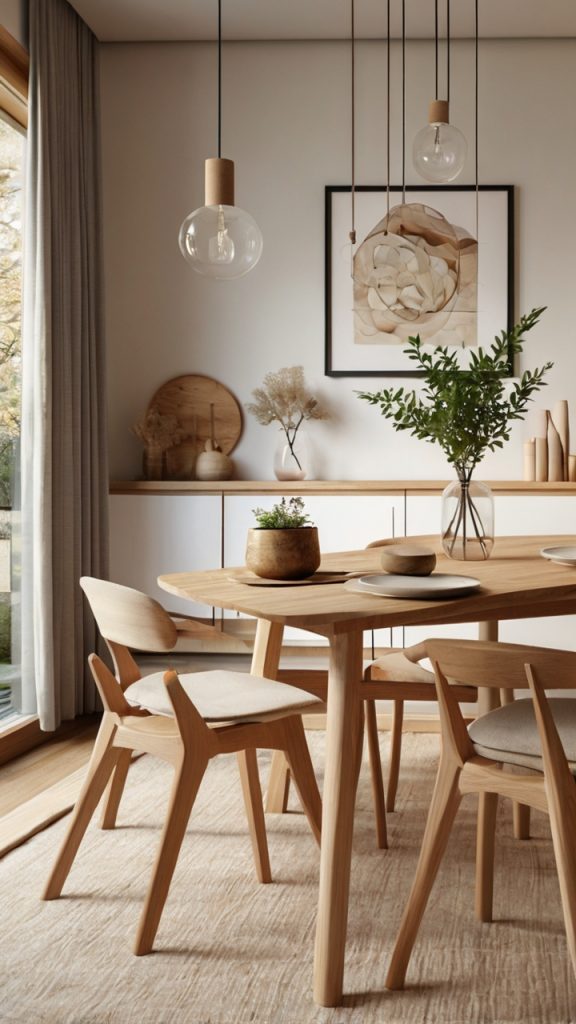
Finding the right chairs feels like dating – you kiss a lot of frogs before finding your prince. The sweet spot? Chairs that combine Scandinavian comfort with Japanese restraint.
I’m obsessed with wishbone chairs or anything with a curved backrest and natural materials. The key is choosing pieces that look substantial enough to be comfortable but light enough to maintain that airy feeling. Avoid anything too bulky or upholstered in loud patterns.
Mix and match works brilliantly here, BTW. Two different chair styles around the same table? Absolutely works if you stick to the same color family and material palette.
Also Read: 15 Stunning Dining Room Wall Decor Ideas to Transform Your
Natural Light and Bamboo Decor
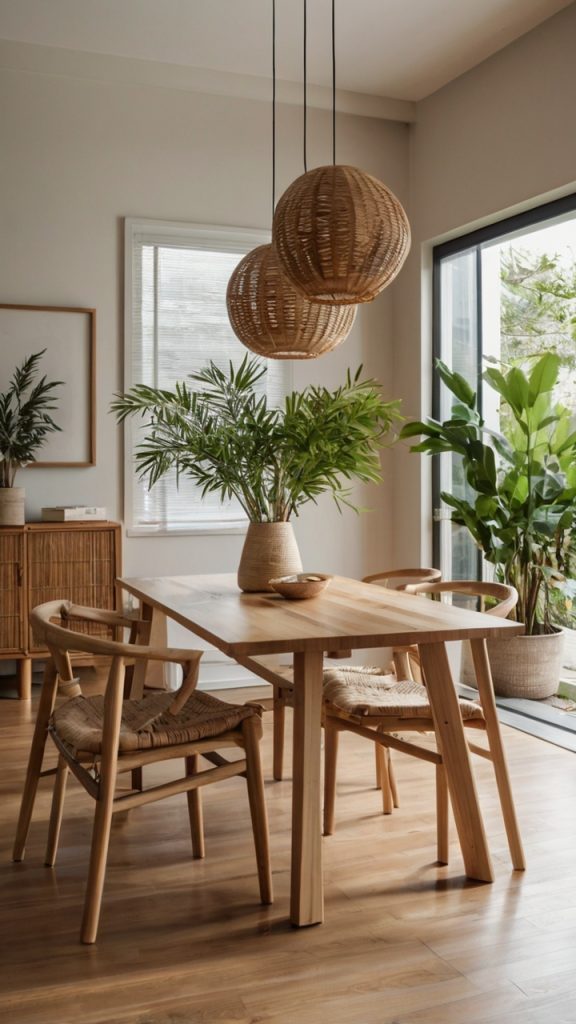
Ever noticed how Japandi spaces always seem bathed in this perfect, soft light? That’s not accident – it’s intentional design. Maximize every drop of natural light you can get.
Ditch those heavy curtains for light linen panels or, even better, simple wooden blinds. I switched to bamboo roller shades last year, and wow – game changer. They filter light beautifully while maintaining privacy. Plus, that natural bamboo texture adds another layer of organic beauty to the space.
Strategic Bamboo Placement
Don’t just throw bamboo elements everywhere like you’re decorating a tiki bar. Use bamboo thoughtfully:
- Window treatments for filtered light
- Room dividers for open-plan spaces
- Small decorative elements like vases or serving trays
- Placemats and table runners for texture
Cozy Japandi Corner Dining Nook
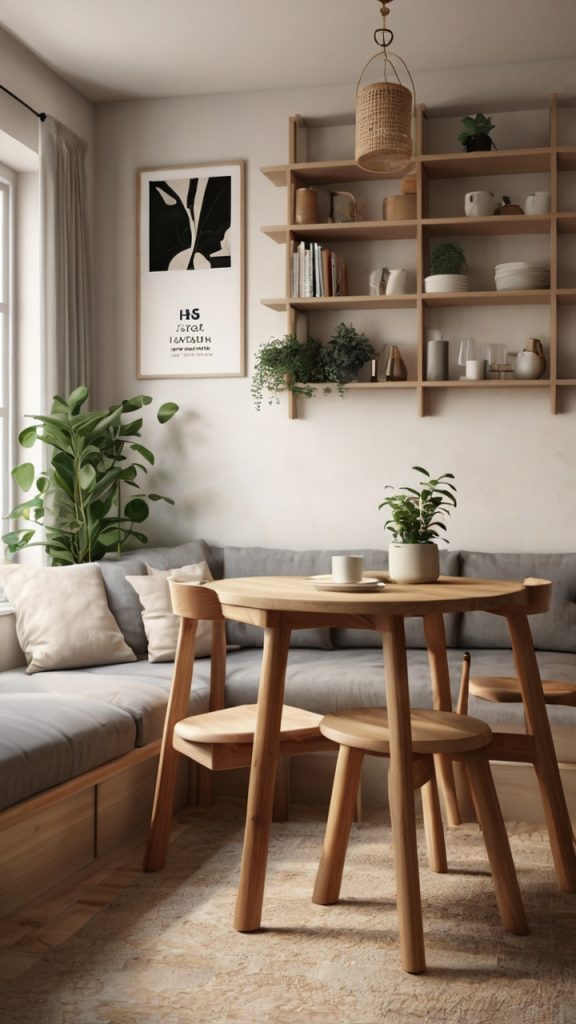
Not everyone has a massive dining room, and honestly? Small spaces often create the coziest Japandi vibes. My sister transformed this awkward corner in her apartment into the most inviting dining nook using just a built-in bench and small round table.
The trick is embracing the intimacy. Add soft cushions in natural fabrics, maybe a sheepskin throw, and suddenly that “problem corner” becomes everyone’s favorite spot. Keep the color palette muted – think oatmeal, cream, and soft gray.
Wabi-Sabi Inspired Table Settings
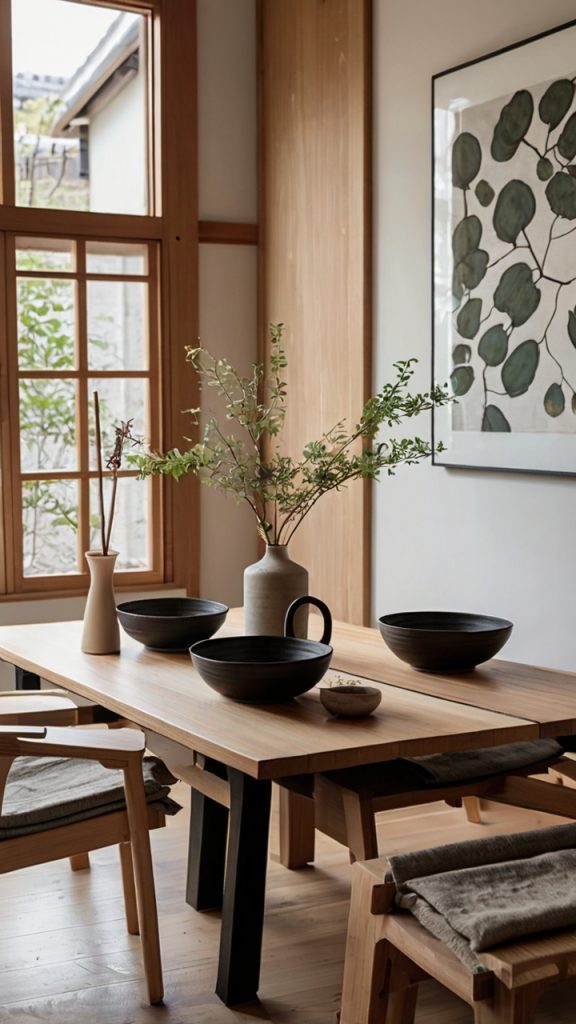
Here’s where Japandi gets really fun. Wabi-sabi celebrates imperfection, which means you can finally stop stressing about matching everything perfectly. Mix handmade ceramics with simple glassware, combine different textures, embrace asymmetry.
My favorite table setting includes:
- Handthrown ceramic plates with visible imperfections
- Simple linen napkins (never paper!)
- Wooden serving boards
- Mismatched vintage glasses
- A single branch in a ceramic vase as centerpiece
The beauty lies in the restraint. Don’t overdo it – less really is more here.
Also Read: 15 Stunning Farmhouse Dining Room Decor Ideas to Inspire You
Sleek Pendant Lighting over Dining Table
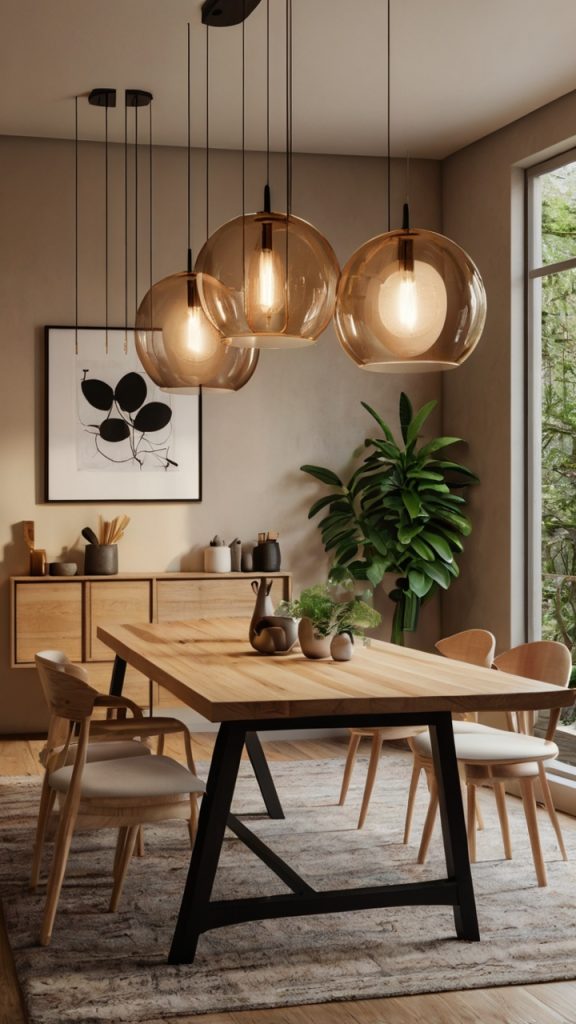
Lighting makes or breaks a dining room, period. The right pendant light becomes a sculptural element that anchors your entire space. Paper lanterns, woven pendants, or simple geometric shapes work beautifully in Japandi rooms.
I learned this lesson after installing these supposedly “minimalist” chrome fixtures that made my dining room feel like a sterile operating theater. Switched to a warm wood and rice paper pendant, and boom – instant atmosphere. The light should be warm (think 2700K-3000K bulbs) and dimmable. Non-negotiable.
Height Matters
Hang your pendant 30-36 inches above the table surface. Too high and it feels disconnected; too low and people bang their heads reaching for the salt. Ask me how I know :/
Mixed Wood and Matte Finish Furniture
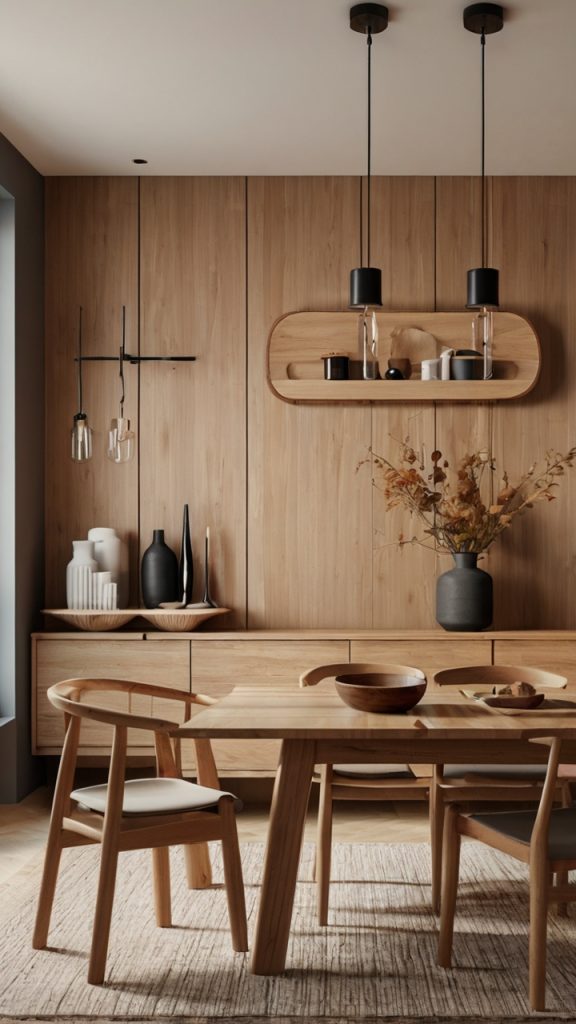
Who says everything needs to match? One of Japandi’s best-kept secrets is the art of mixing woods. Combine light and medium tones for visual interest without chaos.
My dining room currently rocks:
- Light oak table
- Walnut serving credenza
- Ash wood chairs
- Bamboo window shades
The key? Keep all finishes matte or satin – nothing glossy. And maintain a similar undertone across all woods (either warm or cool, not both).
Greenery and Indoor Plants Accents
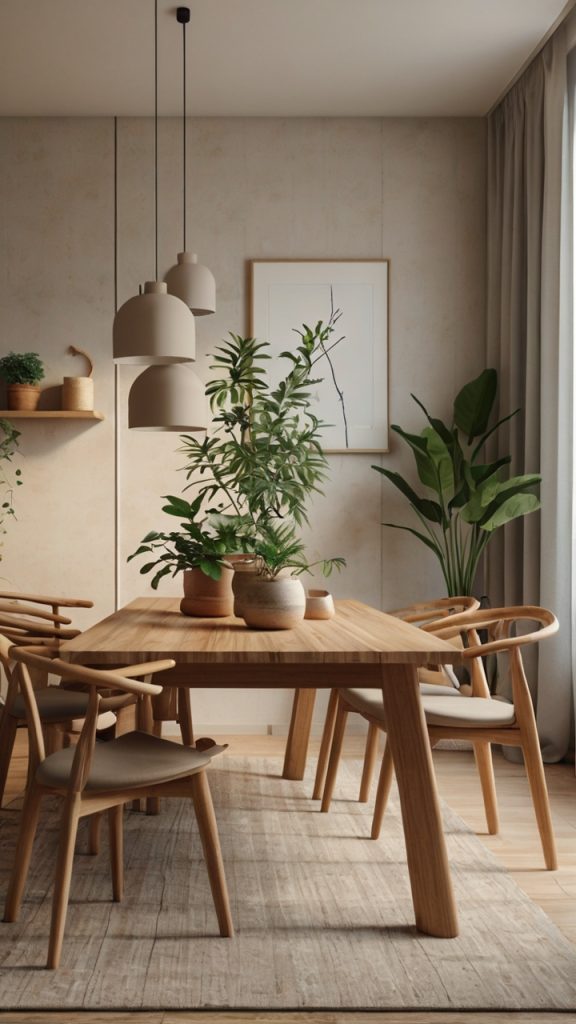
Plants breathe life into Japandi spaces, but we’re not talking jungle vibes here. Choose plants with architectural qualities – think sculptural rather than bushy.
My go-to plants for Japandi dining rooms:
- Snake plants for vertical interest
- Fiddle leaf figs for drama (if you can keep them alive)
- Rubber plants for glossy, substantial leaves
- Bonsai trees for that authentic Japanese touch
- Simple ferns in hanging planters
Place them strategically – one large floor plant in a corner, maybe a small succulent on the credenza. Don’t create a greenhouse; create moments of natural beauty.
Also Read: 15 Stunning Boho Dining Room Decor Ideas for a Cozy
Japanese Sliding Door Room Divider
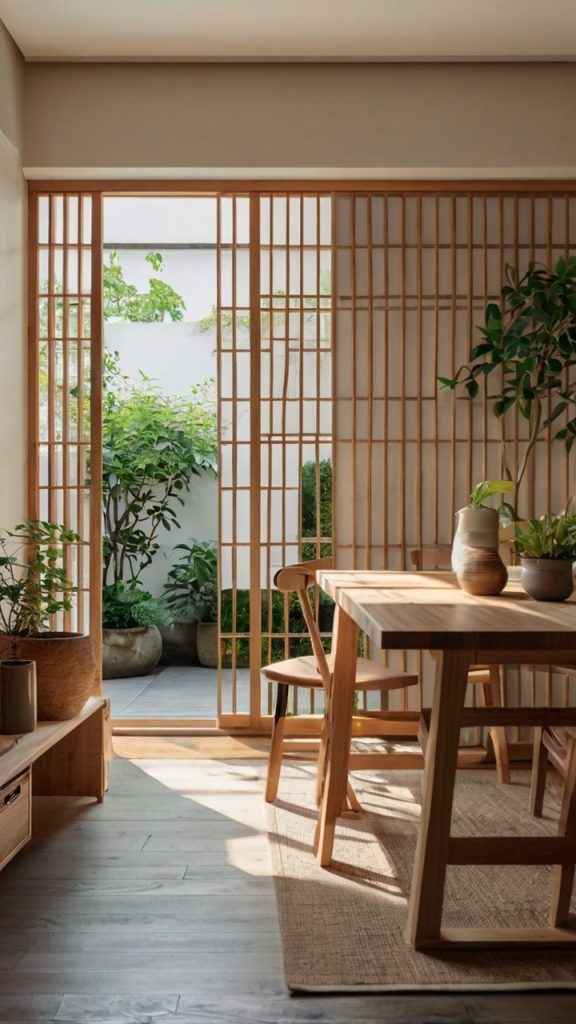
Open floor plans dominate modern homes, but sometimes you need separation. Enter the shoji screen or sliding door – functional art that defines spaces without walls.
I installed sliding panels between my dining and living areas last year, and it’s been transformative. Closed, they create intimate dinner party vibes. Open, the space flows beautifully. The translucent panels maintain light flow while providing visual separation.
DIY Options
Can’t install permanent doors? Try:
- Freestanding shoji screens
- Ceiling-mounted curtain panels
- Temporary room dividers in natural materials
Soft Textiles with Neutral Patterns
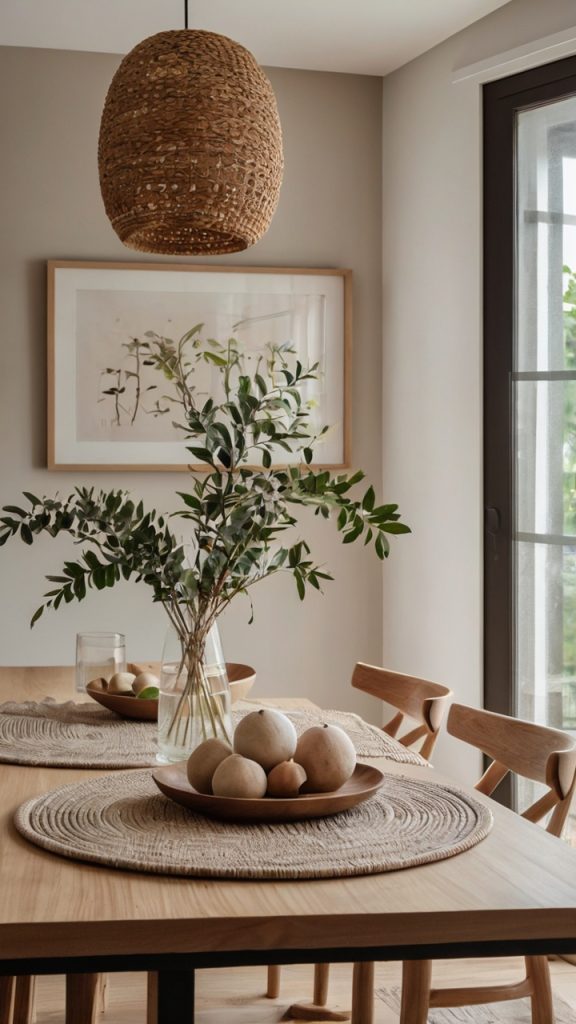
Textiles add warmth to Japandi’s sometimes austere aesthetic. But we’re talking subtle patterns and natural fibers – no loud prints or synthetic materials allowed.
Think:
- Linen table runners in oatmeal or soft gray
- Wool cushions with minimal geometric patterns
- Cotton napkins with simple hem details
- Jute or wool rugs with subtle texture
The pattern rule? If you can see it from across the room, it’s probably too bold. Japandi textiles whisper; they don’t shout.
Open Shelving with Minimalist Decor
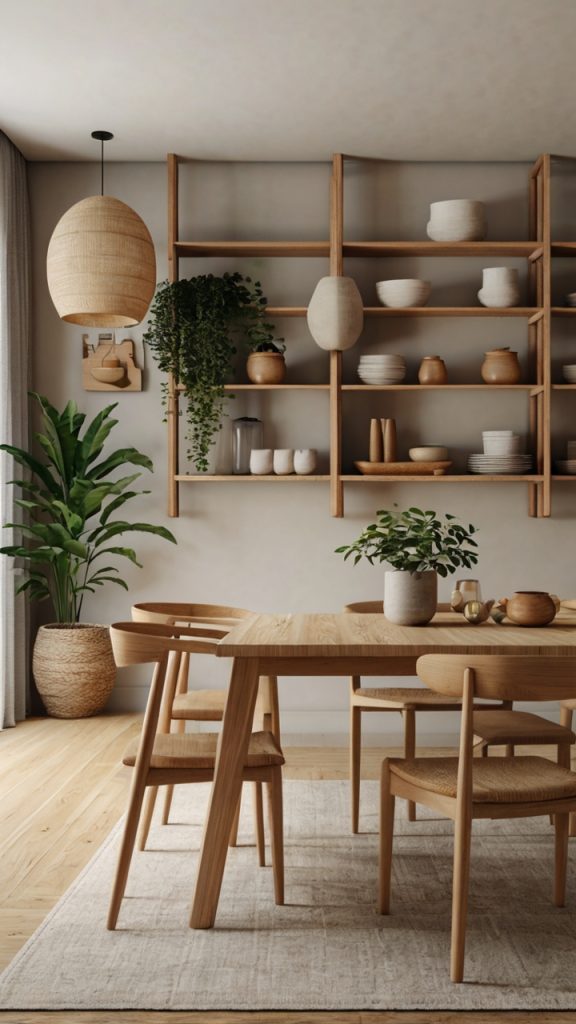
Open shelving works brilliantly in Japandi dining rooms, but here’s the catch – you actually need to keep it minimal. This isn’t the place for your collection of 47 coffee mugs.
Display only your most beautiful pieces:
- A few handmade bowls
- Simple glassware
- Maybe a ceramic vase or two
- A small plant
- Your nicest serving pieces
Everything else? Hidden storage, my friend. The visual calm of sparse shelving contributes massively to that zen feeling we’re after.
The 70/30 Rule
Keep shelves 70% empty, 30% styled. Sounds extreme? Try it. The negative space makes displayed items feel special rather than cluttered.
Zen-Inspired Artwork and Wall Hangings
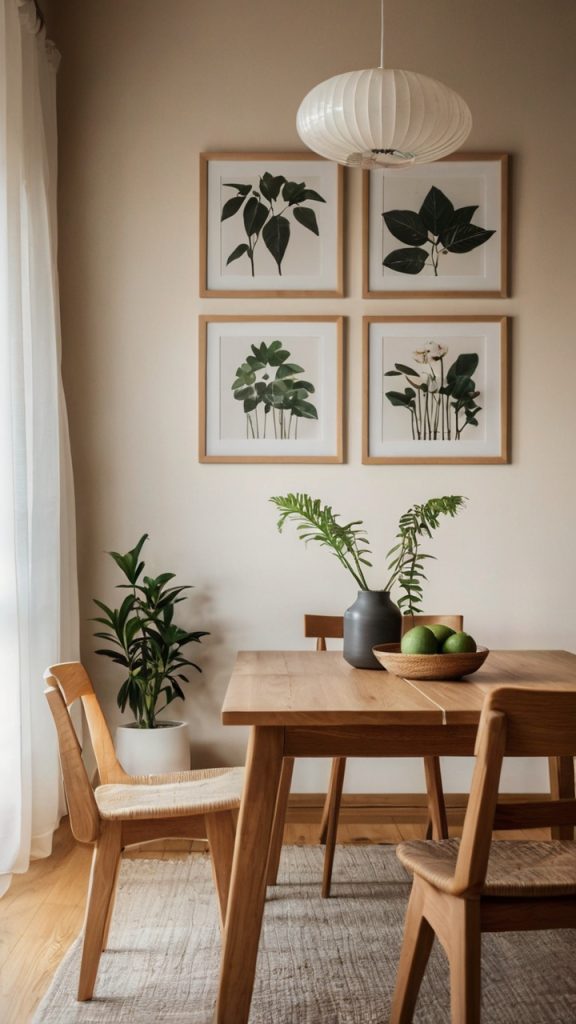
Art in Japandi spaces should enhance, not dominate. Choose pieces that invite contemplation rather than demand attention. Abstract landscapes, simple line drawings, or minimalist photography work beautifully.
I’ve got this single large canvas with an abstract mountain scene in soft grays and whites. It adds interest without screaming for attention. That’s the sweet spot – art that complements rather than competes.
Consider also:
- Textile wall hangings in natural fibers
- Simple wooden sculptures
- Black and white photography
- Minimalist prints in thin frames
Low-Profile Dining Benches with Cushions
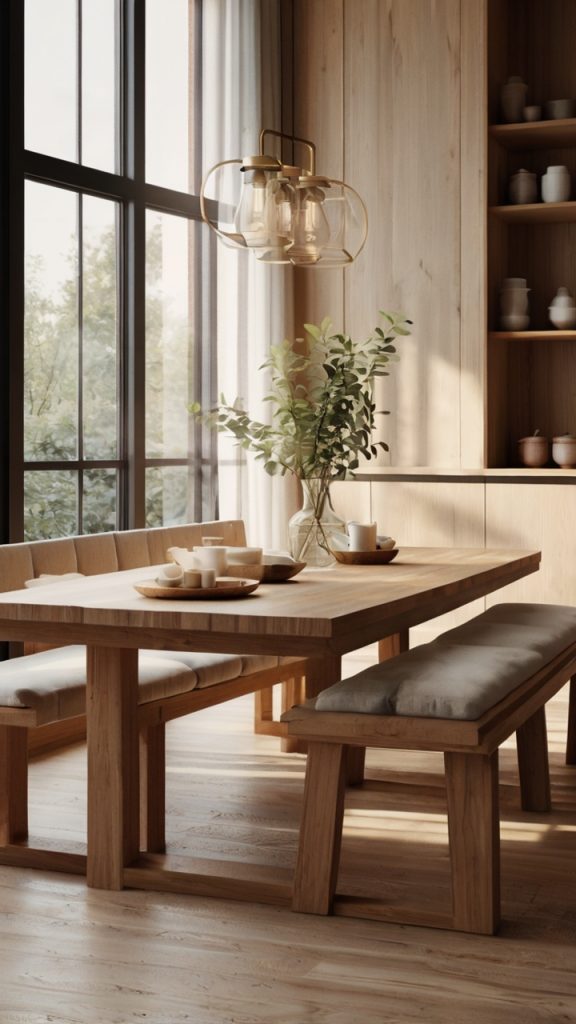
Benches bring that casual, communal feeling that makes Japandi dining rooms so inviting. Low-profile designs maintain sight lines and create visual space, especially in smaller rooms.
Add simple cushions in natural fabrics for comfort. I’m partial to linen or canvas in neutral tones. The beauty of benches? They tuck completely under the table when not in use, maximizing floor space. Plus, they’re perfect for squeezing in extra dinner guests – way better than dragging chairs from other rooms.
Mixing Benches and Chairs
Don’t feel locked into all benches or all chairs. Mix them up – bench on one side, chairs on the other. It creates visual interest and offers seating options for different preferences.
Minimalist Tableware and Natural Accessories
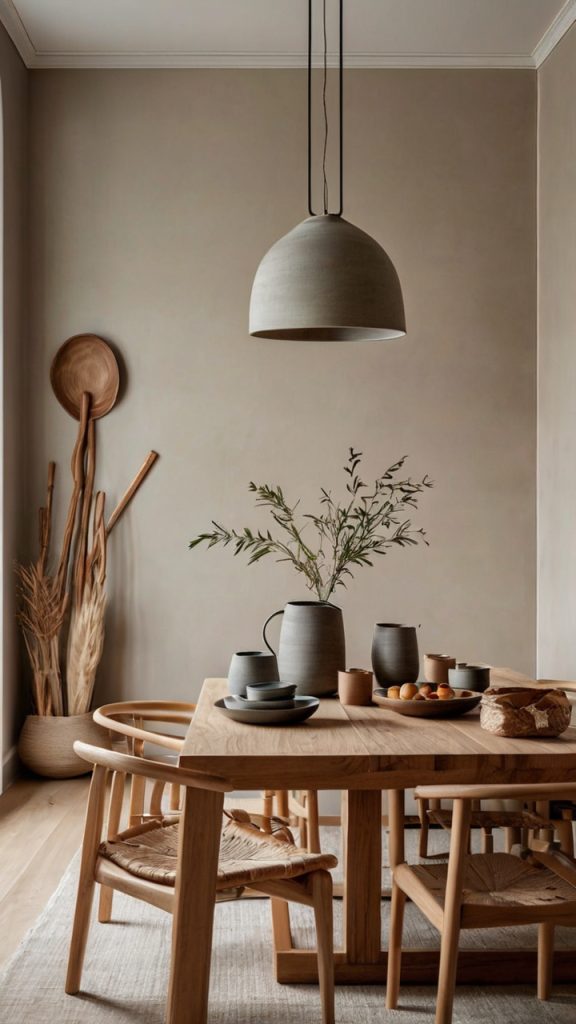
Your tableware choices make a huge difference in achieving authentic Japandi style. Invest in quality over quantity – better to have six beautiful plates than twenty mediocre ones.
Look for:
- Handmade ceramics with organic shapes
- Simple wooden serving pieces
- Clear or smoky glassware with minimal design
- Natural fiber placemats and runners
- Wooden or ceramic serving bowls
Skip the fancy china patterns and ornate silverware. Japandi tableware celebrates the beauty of simplicity and natural materials. Every piece should feel good in your hands – weight, texture, and temperature all matter.
The Art of Table Styling
When setting your Japandi table, remember:
- Layer textures, not colors
- Use odd numbers for centerpieces (one large vase or three small ones)
- Keep decorative elements low to maintain conversation flow
- Choose seasonal elements like branches or simple flowers
- Never overcrowd – breathing room is essential
Bringing It All Together
Creating a Japandi dining room isn’t about following rigid rules – it’s about finding that perfect balance between Scandinavian coziness and Japanese minimalism. Every choice should feel intentional, from your dining table to your smallest decorative object.
The real magic happens when these elements work together. Your minimalist wooden table anchors the space, while soft textiles add warmth. Natural light flows through bamboo shades, highlighting the subtle textures of your neutral walls. Plants add life without chaos, and carefully chosen art provides visual interest without overwhelming.
Remember, Japandi isn’t about perfection – it’s about creating a space that feels both beautiful and livable. Start with one or two ideas from this list and build from there. Maybe begin with a new dining table or simply declutter your existing shelves. Small changes add up to dramatic transformations.
FYI, you don’t need to implement all 15 ideas at once. Pick what resonates with your space and lifestyle. The best Japandi dining rooms evolve naturally over time, collecting meaningful pieces and shedding unnecessary clutter along the way.
Your dining room should be a place where meals become memories, where the space itself encourages lingering conversations and peaceful moments. That’s the true gift of Japandi design – creating rooms that don’t just look good but actually feel good to inhabit.
So, which idea are you tackling first? Whatever you choose, remember that the journey toward your perfect Japandi dining room should be as enjoyable as the destination. After all, isn’t that zen approach exactly what this style is all about? 🙂
